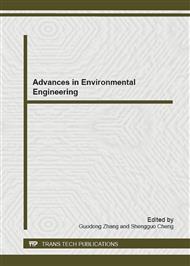p.268
p.272
p.278
p.282
p.289
p.295
p.299
p.305
p.309
Effects of Adding Nitrifying Bacteria on Microbial Communities and Nitrification in a Laboratory-Scale a/O Reactor Treating Leather-Tanning Wastewater
Abstract:
A laboratory-scale anoxic/oxic reactor was used to analyze the effects of adding nitrifying bacteria on microbial communities in the treatment of leather-tanning wastewater. The reactor was operated in series in continuous flow mode for 25 d after an acclimation period of 45 d, and the nitrifying bacteria were added after the acclimation period. The addition of nitrifying bacteria into the wastewater significantly enhanced NH4+-N removal efficiency. The Arrhenius and Jacob-Monod models were applied to determine the optimum and acceptable operating conditions for this process. The optimum temperature range and concentration of dissolved oxygen were 15-30 oC and 5 mg L-1, respectively. Use of Nitrosomonas europaea and Nitrobacter were considered reliable for leather-tanning wastewater treatment due to their dominant status as nitrifying bacteria. Substrate half-saturation constants for ammonia oxidizing bacteria and nitrite oxidizing bacteria were 24.13 mg L-1 and 5.43 mg L-1, respectively.
Info:
Periodical:
Pages:
289-294
Citation:
Online since:
November 2012
Price:
Сopyright:
© 2012 Trans Tech Publications Ltd. All Rights Reserved
Share:
Citation:


